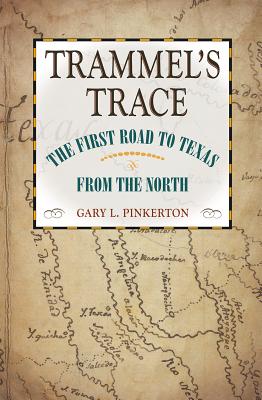
Trammel's Trace: The First Road to Texas from the North (Red River Valley Books, sponsored by Texas A&M University-Texarkana #5)
Description
Trammel’s Trace tells the story of a borderlands smuggler and an important passageway into early Texas.
Trammel’s Trace, named for Nicholas Trammell, was the first route from the United States into the northern boundaries of Spanish Texas. From the Great Bend of the Red River it intersected with El Camino Real de los Tejas in Nacogdoches. By the early nineteenth century, Trammel’s Trace was largely a smuggler’s trail that delivered horses and contraband into the region. It was a microcosm of the migration, lawlessness, and conflict that defined the period.
By the 1820s, as Mexico gained independence from Spain, smuggling declined as Anglo immigration became the primary use of the trail. Familiar names such as Sam Houston, David Crockett, and James Bowie joined throngs of immigrants making passage along Trammel’s Trace. Indeed, Nicholas Trammell opened trading posts on the Red River and near Nacogdoches, hoping to claim a piece of Austin’s new colony. Austin denied Trammell’s entry, however, fearing his poor reputation would usher in a new wave of smuggling and lawlessness. By 1826, Trammell was pushed out of Texas altogether and retreated back to Arkansas Even so, as author Gary L. Pinkerton concludes, Trammell was “more opportunist than outlaw and made the most of disorder.”
Praise for Trammel's Trace: The First Road to Texas from the North (Red River Valley Books, sponsored by Texas A&M University-Texarkana #5)
“Pinkerton’s glimpse at Trammel’s Trace as a ‘smuggler’s back alley’ into Northeast Texas offers a refreshing tale about other roads and characters beyond the traditional narrative of colonization in the Lone Star State. The transformation of Nicholas Trammell from clandestine trader to settled farmer and slaveholder by the early 1840s is a reminder that there remains more to learn about early immigrants to Texas than meets the eye. Pinkerton relates Trammell’s journey in a well-written, narrative style that different audiences may share alike.”—Dr. Francis X. Galan, Assistant Professor of History at Texas A&M University-San Antonio
— Francis X. Galan
“Gary Pinkerton’s book Trammel’s Trace, The First Road to Texas from the North is an impressive contribution to our understanding of the nineteenth-century settlement of eastern Texas. For the first time, a comprehensive compilation has been made about Trammel’s Trace and the life of Nicholas Trammel, the man who developed the trail system to first smuggle contraband and later to engage in legal commerce in Texas. Pinkerton is the perfect author of this study, having personally located many present-day remnants of the trace with his team of historians and archaeologists. Pinkerton’s exhaustive research in Texas, Arkansas, and other archives has enabled him to describe the trace with stunning detail and to make a plea to the present generation about the urgent need to preserve the parts of the trace that still exist. Moreover, his presentation of Nicholas Trammel’s life from Tennessee to Texas appropriately highlights the contributions Trammel made to Texas. Anyone interested in the history of settlement in the Lone Star State will want this book for their library.” — Jim Bruseth
— Jim Bruseth
“Western expansion following the Louisiana Purchase created turbulent pressures on the boundaries of Spanish Texas and the United States, that neither nation could afford to ignore. During these disquieting years the sparsely patrolled frontier and the lure of lucrative trade in horses gave rise to numerous smugglers in the wild fringes of Texas and none were more colorful than Nicholas Trammell. Pinkerton’s wonderfully written and meticulously researched history of Trammel’s Trace follows the life of Nicholas Trammell, exposing him as both a scoundrel and an entrepreneur. Pinkerton leaves no doubt that Nicholas Trammell, like all the shadowy figures associated with the early borderlands of Texas, played an integral part in opening Texas to those who wished to emigrate to the United States. Trammel’s Trace, while belonging to history as a smugglers' trail turned artery of early Texas colonization, exists today as dim paths through forests or as shallow swales across forgotten pastures, and, in some places, as county roads and highways. In his book, Pinkerton has expertly demonstrated the depth of his research through the retracement of this early and often obscure road across the landscapes of today. Backed by solid evidence from dedicated examinations of landownership abstracts and historic maps and documents, as well as sifting through voluminous antecedent documents, Pinkerton has written a compelling and intriguing story of the origin and evolution of an early Texas road that no historian should be without.” —Jeffrey M. Williams, Stephen F. Austin State University
— Jeffrey M. Williams
“A self-proclaimed “rut nut” prone to ground-truth his research, Gary L. Pinkerton brings considerable historical and geoarchaeological skills to bear in his in-depth analysis of an often-overlooked early route to Texas. This is, at one level, a detailed biography of a road, but in focusing on a line through the Texas prairies and woodlands that predated formal Anglo-American colonization of the area, the author also makes significant, defining connections that give the reader much more to consider.”—Southwestern Historical Quarterly
— Southwestern Historical Quarterly
“Pinkerton’s passion is contagious, and his enthusiasm will strike a chord with lay readers as well as scholars of early Texas history.” —Central Texas Studies
— Central Texas Studies
"I recommend this book to historians interested in early-nineteenth-century Texas, Louisiana, Arkansas, the Southwest, or frontier history. Historians, sociologists, anthropologists, and archaeologists interested in frontier theory will also find it engaging. Though he covers a lot of ground, Pinkerton writes in a style that will maintain the interest of the nonspecialist."—Journal of Southern History
— Journal of Southern History

